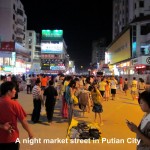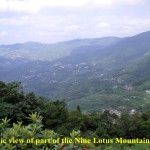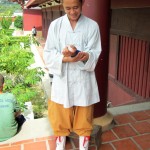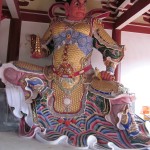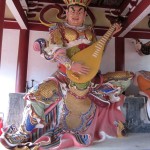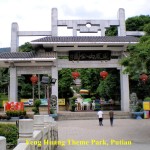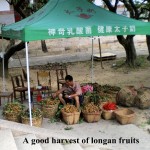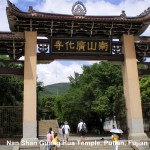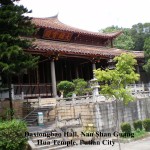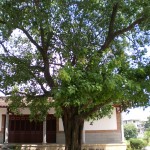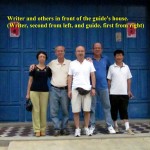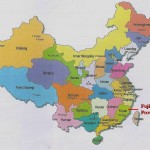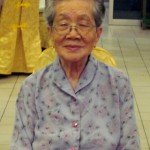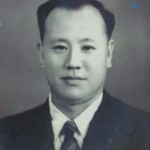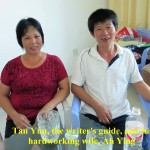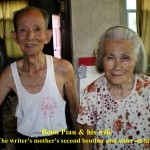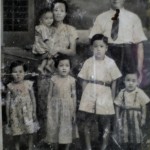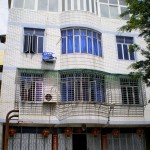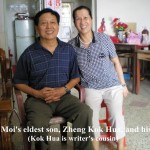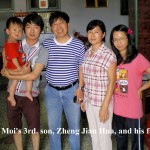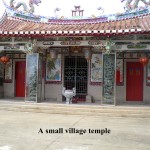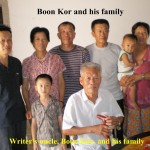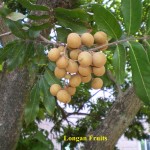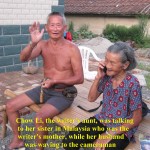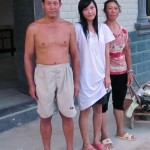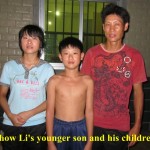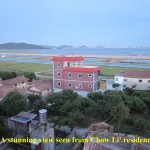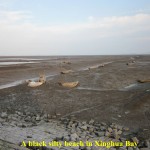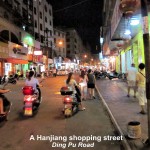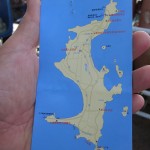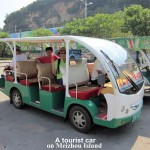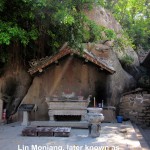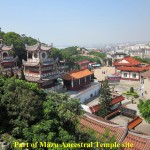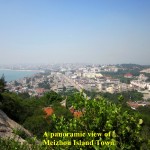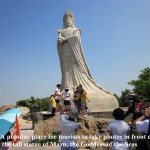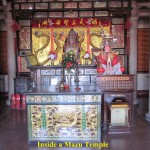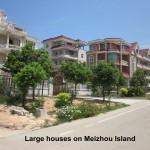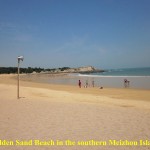China Relatives and Ancestral Places III (Putian, Fujian Province)
Filed under: China Relatives and Ancestral Places III (Putian in Fujian Province), China(Relatives)
(Continued from China Realtives and Ancestral Places II)
At 2 p.m. we left the island in the same old boat that it had brought us to the island in the morning. When the boat was going to leave the pier for the mainland we were shocked to see an old man, suddenly, appeared from nowhere near our boat. He was sitting on a small square polystyrene float with a pair of slippers beside him and kept rowing with a bamboo stick. I thought he was crazy trying to row across the channel to the mainland to save the ferry ticket.
As our boat was moving away from the Meizhou Island towards the mainland, I kept watching him. Then, a few minutes later, I saw him making a U-turn and rowing back to the island. I was amused and felt relieved, but wondered why he was doing that.
Day 5 Tuesday 7 September 2010
Shopping in Hanjiang Town
In the morning, Brother Tan Yun brought us to a trading centre of wholesale shops in Hanjiang Town. Those shops were selling many kinds of things, cheaply, such as tea leaves, dried seafood, apparels, shoes, electrical and electronic products, etc. We spent several hours at a few shops there and bargained with the shopkeepers over the prices of the things we wanted to buy. Inspite of our worries about the quality of the electrical and electronic goods, all of us bought something there. We found that the prices of those goods there, like handphones, MP4 players, i-Robots(like the i-Pad), GPS, etc. were very much cheaper than in my country.
“The First Tunnel”, Putian City
In the evening, we went to Putian City. On arrival in the city centre, we went to a popular night-market street. Besides shops on both sides of that long, wide street, there were hawkers selling merchandise in the in the middle of it.
While we were there we were appalled at the sight of the street. It was dusty and dirty, and large holes were everywhere. Later, we discovered that an underground shopping mall was under construction. It was to be known as “The First Tunnel”.
Workers were working round the clock, digging below the street, removing the earth and pumping dirty water out of the tunnel onto the street. Besides, lorries came to load and take away the earth, and other lorries came to deliver mortars for the underground structures.
When we reached the end of the street we saw a red wall which looked like the front gate of the Forbidden City in Beijing, but it was smaller and without a photo of Chairman Mao Tze Dong. Then we left the street for Brother Tan Yun’s house in Tie Zao Village in Nanxing and near Hanjiang Town.
Day 6 Wednesday 8 September 2010
Nanshaolin Temple, Putian, Fujian Province
In the morning, we went to a Buddhist temple, Nanshaolin Temple, which is 58 km north of Putian City. It is well-known for a Chinese martial art, Wushu. Located in a basin at a height of about 600 metres and surrounded by nine mountains known as Nine Lotus Mountains(Jiulian Shan), the original temple was built in A.D. 557. Later, during the war between the two dynasties, Qing and Ming, it was burnt down by the former troops.
In 1998, the Fujian Province government spent more than RMB 80 millions to rebuild and enlarge the Nanshaolin Temple site. Now it covers an area of about 20 hectares attracting lots of visitors from near and far.
To go to the temple, we had to drive up a long but winding road. While travelling up the mountains, we could see
beautiful sceneries of the mountains, lowlands and the city of Putian in the distance. On arrival at the temple, we were greeted by a large arch with four Chinese characters which told us that it was Nanshaolin Temple(or South Shaolin Temple). Besides being a Buddhist temple, monastery and religious school, Nanshaolin Temple is a world well-known Chinese martial art(Wushu) training school for both young and old enthusiasts. There are many beautiful bright-coloured buildings of worship there. But the most important one is the largest shrine known as Daxiongbao Temple which houses three large golden statues of Lord Buddha and 18 small golden statues of monks.
There is one building where a large statue of smiling Buddha is placed in the middle and watched by four large statues of fearsome looking figures. They are known as “The Four Heavenly Kings”(“Si Da Tianwang” in Chinese). They are called:
a. The Heavenly King of the North
He holds a pagoda in his right hand and a pet in his left one.
b. The Heavenly King of the East
He plays a Chinese musical instrument known as “pi-pa”.
c. The Heavenly King of the South
He has a black face and holds a sword.
d. The Heavenly King of the West
He holds a dragon in his right hand and a golden pearl in his left hand.
According to the Buddhist faith, the four heavenly kings are Buddha’s protectors. Besides, each of them watches over a cardinal direction of the world(East, West, North or South), and they are believed to protect the world form evils.
Feng Huang Theme Park, Putian
After an interesting tour of the world famous Nanshaolin Temple, we descended the mountain and headed for a theme park known as Feng Huang Theme Park or Phoenix Theme Park in Putian City. This is a place where there are 15 exciting activities, such as riding a large swinging pirate boat, sitting in aeroplanes that go round and round, encountering ghosts in a cave, riding bumper cars, pedalling boats in a lake, ice-skating, riding mechanical horses, etc. On arrival at the park, we all decided not to enter the park as we were tired and the day was hot. Besides, we felt too old for those activities.
After a few minutes of looking around the place outside the theme park, we left and went to a well-known Buddhist temple which is 3 km south of Putian City. It is known as Nan Shan Guang Hua Temple.
Nan Shan Guang Hua Temple, Putian City
This temple is located at the foot of Nan Shan or Feng Huang (Phoenix) Mountain. It was first built in 558 A.D. as a Buddhist monastery. It has a long history of over 1,400 years of good and bad times. It enjoyed the best time during the Song Dynasty(960-1279) when it had about 1,000 monks and nuns. It was once destroyed by fire during a war in the Yuan Dynasty(1271-1368), but it was restored in the Ming Dynasty(1368-1644).
During the Cultural Revolution(1966-1976), all the Buddhist statues were destroyed and the monks were expelled from the temple. Then it was turned into a factory. After the revolution, the Chinese government allowed the temple to be reopened. With donations pouring in from overseas Chinese, it was rebuilt in 1984 with more religious buildings giving it a new look. The main building is known as Daxiongbao Hall. It now covers a large area of 40,000 sq. metres.
Bodhi Tree
When we entered the temple site, we were amazed to see a lot of longan trees which were bearing fruits then. The trees made the site a cooling place during the hot day then. Besides, there was a tall Bodhi tree outside the temple. That tree is significant to Buddhists as they believe that Buddha achieved
enlightenment when he was under a large Bodhi tree in India.
After a tour of the serene Guang Hua Temple, we left for late lunch and returned to Brother Tan Yun’s house to rest our tired bodies.
Day 7 Thursday 9 September 2010
Departure for Malaysia
We had to leave China today. In the morning, we thanked our hosts for their kind hospitality. They had allowed us to stay at their large mansion in a small village, Tie Zao, in Nanxing near Hanjiang Town for the last four days. Then our good guide, Brother Tan Yun, drove us in his car to Xiamen Airport to catch a flight home, Malaysia. We had missed our families in the country for the last seven days.
After traveling on the well-built expressway from Hanjiang for two hours we finally reached the airport. At the airport, we thanked and bade farewell to Brother Tan Yun. He hoped that we would come back again to visit him and our relatives for a longer period.
In the evening, we, finally, left the Xiamen Airport for home bringing back with us rich memorable experiences of our first visit to our relatives and their villages in Fujian Province in China. Our tour guide, Brother Tan Yun, our tour guide, has done us a good service and we will always remember him.
China Relatives and Ancestral Places I (Fujian Province)
Filed under: China Relatives and Ancestral Places I (Fujian Province), China(Relatives)
China Relatives and Ancestral Places I
(Fujian Province)
A Visit to My Parents’ Relatives and Ancestral Places in China (Fujian Province)
After a Shanghai trip in China in June 2010, a few months ago, I thought it was time for my siblings and I to visit my parents’ relatives and ancestral places in Fujian Province in China.
A month before I made the trip there, I bought four air tickets for my wife, my two brothers and myself to fly there from my country, Malaysia. It would be our first and unforgettable trip.
My Mother
My 86 year-old mother, Tan Chea Pang, has always told me, fondly, about her two brothers and a sister, and my father’s brother and sister living in China. She has visited them several times before. We wanted her go with us very much that time, but, unfortunately, her weak right leg would not allow her to walk much.
Besides, she refused to use her wheel-chair. So four of us decided to make the trip together.
My Father
In the late 1930’s, my father, Lim Ah Kho, married my mother and left his small village, Or Por, near Jiangkou Town in Fujian Province of China without her to seek his fortune, first, in Singapore, then in Johor of Malaya(now Malaysia). Then World War II came to Malaya in 1941. When it was over in 1945, he went back to China to bring my mother to Malaya(Malaysia now). Later, she bore him a total of ten children whose ages range from 45 to 62 years now, and I am the eldest among them. About four decades ago, my poor father passed away at the age of 57.
Our China Tour Guide, Brother Tan Yun
Many overseas Chinese want to search for their relatives and ancestral places in China, but some of them find difficulty in finding
them due to loss of contact by their parents or grandparents. But, I am fortunate because my mother has visited her relatives in China a few times. Besides she has their phone numbers. With the phone numbers, I contacted her relatives a month before we left for China, and told them about my intention of meeting up with them.
At first, I thought it would be a problem to locate them in China, but later, I felt relieved when one of my brothers, Choa Loon, informed me that he had a China friend, Brother Tan Yun, who was living near our relatives’ villages. He had agreed to be our tour guide and would help us to find our relatives.
Day 1 Friday 3 September 2010
Travelling to China
Finally, after a month of waiting , my two brothers, Choa Loon and Cho Tat, my wife, Peng , and myself left
our hometown, Kluang, in Johor, Malaysia and went to the Singapore Changi International Airport on 3 September 2010 to take a flight to Xiamen(formerly known as Amoy) in China.
At 8.20 a.m. our plane, Airline China, took off, flew for about four hours without a hitch and landed, safely, at the Xiamen Airport. Coming out of the airport, we were delighted to meet our guide, Brother Tan Yun. After loading our luggage in his car, we were on our way to the villages to pay our relatives the first visit.
Uncle Boon Piau
After two hours of smooth travelling on an expressway, we arrived at Jiangkou Town and checked in at a hotel, Min Motion Hotel, freshened up ourselves and left for a small village, Hui Aw, to visit Uncle Boon Piau in the afternoon. He is my mother’s second brother. With the help of Brother Tan Yun, we found his house, easily. That old, thin, healthy man of 80 years old was living with his wife in an old double-storey house. His three children were married and living in other places.
Old Photos
We, Malaysian Chinese, had some difficulty communicating with Uncle Boon Piau and his wife, as our Xinghua dialect was a mixture of Malaysian and Chinese words. Luckily, our guide, Brother Tan Yun, came to our aid. He has been to my country a few times and could understand what we were saying. So he became our interpreter.
While we were chatting with the old couple in their living room, some old, faded, dirty, black and white photos in a large picture frame hanging on a wall caught my attention. Among them, I was surprised to see my marriage photo of 1972, a family photo of 1955 showing my parents, two brothers, two sisters and myself when I was 7 years old, and my mother’s photo when she was 67 years old. I, quickly, took out my digital camera and snapped the photos which I wanted to show and surprise my mother in Malaysia, later. Uncle Boon Piau told me that those photos were sent by my mother a few decades ago.
Uncle Boon Toh and Aunty Kek Wah
Before we left Uncle Boon Piau, we asked him for the place where his younger brother, Uncle Boon Toh, lived. Instead of giving us the direction, he asked us to follow him to the house. We found out later that it was just across a wide road and not far from his house.
Arriving at Uncle Boon Toh’s house, we were welcomed by a smiling lady, Aunty Kek Wah. She, sadly, told us that her husband, Boon Toh, passed away last year at the age of 76. Then she regained her composure and invited us into her house.
New Large Modern House
Looking at her new, large modern house which was three storeys high, we, Malaysian visitors, felt poor as we owned either one- or two- storey houses. We praised her for her capability to own such a large mansion. But, she explained that her children who were working overseas built it with their earnings.
Beautiful View
Then she proudly showed us all the rooms. When we were on the top floor of her house we saw a beautiful view of some old Chinese traditional houses with red-tiled traditional roofs, vegetable farms, paddy fields, and longan trees nearby; and
Xinghua Bay and Jiangyin Port in the distance. (The port will be Fujian’s largest port in the near future.) We were surprised to see several new three- and four-storey houses nearby. I guessed those houses were built by the old villagers’ children who were working overseas too. But I could not understand why those children should build large houses with so many rooms for their old parents.
After a long chat with Aunty Kek Wah, we bade her farewell and went back to Jiangkou Town to have dinner before we retired at Min Motion Hotel.
Day 2 Saturday 4 September 2010
Aunty Chui Moi
In the late morning, we planned to visit my father’s sister, Aunty Chui Moi, who was 81 years old. When we
arrived at her house in a small, quiet village known as Or Por, which is near Hui Aw Village, we were told by her husband, Uncle Ah Nui, that his third son had sent her to a hospital for her heart problem. While waiting for her return, we looked at a row of five three-storey houses and told ourselves that she should be a very rich lady. But her eldest son, Cousin Kok Hua, who knew what we were thinking, quickly, told us that it was built by his second brother, Cousin Jia Hua, who had made a fortune in Italy. It sounded familiar: a case of large houses built by children who worked overseas.
We had a good conversation with Cousin Kok Hua, his father and other members in the house. At about 1 p.m., we had lunch at the house. It was a simple, home-prepared meal of the local rice noodle cooked with fresh seafood from the nearby sea, Xinghua Bay. It tasted so good that all of us from Malaysia had a second helping, thanks to Aunty Chui Moi’s two daughters-in-law who cooked it.
Later, Cousin Kok Hua brought us around his village. He showed us an old abandoned house nearby where my father married my mother in the 1940’s, a small Lim Clan Memorial house, a village temple which was newly built from donations from the Lims, Tays and Tans, and a large building which was under construction. The latter was going to be the new Lim Clan Memorial House, replacing the old one. As it had insufficient fund for its completion, Cousin Kok Hua appealed to us for some donations. (Later, when we were in Malaysia we sent him some money for the building fund.)
Uncle Boon Kor
Cousin Kok Hua also brought us to see two old, vacant houses which faced each other and told us that my father’s parents were living there before they passed away a few decades ago. Finally, he brought us to see my father’s brother, Uncle Boon Kor, living in the same village as his. We were welcomed by him, his three adult sons and two
daughters-in-law. We had a long chat with him. We were surprised that he could speak a little bit of Malay language. He told us that he worked for a few years when he was a teenager in Malaya(now Malaysia) in the 1950’s and learned the language from the local Malays.
During our conversation, one of Uncle Boon Kor’s sons brought into his house a lot of longan fruits. They were from his orchard. We, Malaysian visitors, like this type of fruits as they are sweet and juicy. We took quite a lot of them.
After spending an hour at Uncle Boon Kor’s house, we were, pleasantly, surprised to see three visitors, two ladies and a man, appear. They told us that they were Uncle Boon Piau’s children(or our cousins). We were happy to see each other for the first time and had a good talk.
Later, we were informed that Aunty Chui Moi was back from the hospital. We went back to her house and greeted her. Although she looked weak due to her heart ailment she made an effort to smile. We were glad that she was happy to see us.
Aunty Chow Li
In the evening, we bade farewell to Aunty Chui Moi and left for another village to visit another aunt. She lived in a Jiangkou village, Kan Now, which was a few kilometres from Aunty Chui Moi’s residence. She is my mother’s sister called Aunty Chow Li. She was then 83 years old.
Before we visited Aunty Chow Li, we phoned her telling her our intention of seeing her. When we arrived at her village we were surprised to see Aunty Chow Li, a thin, old, sun-tanned and hunched lady, standing on the side of a wide road with her two grandchildren and waiting for us.
On arrival, we greeted her and followed her to her house. When we arrived at her house we were surprised again to see her new, beautiful, modern three-storey house built in front of her old traditional one-storey one. Her daughter-in-law, proudly, told us that the large house was built from the earnings remitted from her children who were working overseas- another case of houses built on children’s foreign earnings.
Aunty Chow Li’s elder son showed us the new house inside. As he showed us around he told us, proudly, that he and his father built the house with the help of a few friends.
Standing on the flat rooftop of the house, we saw the awesome scenery of the village and the Xinghua Bay similar to the one we saw from Aunty Kek Wah’s house in Hui Aw Village which is a few kilometres away. We spent about an hour getting acquainted with all my aunt and her family.
Before we left, we were surprised when her younger son gave us some live crabs and clams he caught in the Xinghua Bay which is less than two kilometres away. On the following day, Brother Tan Yun, our guide, cooked them together with rice noodle for our lunch at his house. We ate it with great relish.
(Continued on China Relatives and Ancestral Places II (Fujian Province, Meizhou Island))
China Relatives and Ancestral Places II (Fujian Province, Meizhou Island)
Filed under: China Relatives and Ancestral Places II (Fujian Province and Meizhou Island), China(Relatives)
(Continued from China Relatives and Ancestral Places I)
Chinese Relatives and Ancestral Places II
(Fujian Province, Meizhou Island)
(Day 3 Sunday 5 September 2010
After visiting all my relatives for the past two days, we decided to do some shopping and visit some
places of interest for the rest of our vacation.
In the morning we checked out of the hotel because Brother Tan Yun, our guide, invited us to put up at his house. It was in Tie Zao Village in Nanxing near Hanjiang Town. His hospitable mother and wife welcomed us, and took care of our meals and laundry. Brother Tan Yun’s newly built large house of three storeys next to his old one surprised us. When we asked him about it he told us that he had made a small fortune overseas and built it. He built it large to “show off’ to his villagers. That was another case of a large house built by a successful son who had earned lots of money overseas to build a large modern house to “show off”.
In the evening, one of my brothers, Cho Tat, and I decided to take a walk from the house to the Xinghua Bay. We needed that walk to burn off some of our fat as we had been eating too much delicious food, lately. At first, we thought it was a short distance to the beach. Later, we realised that it was quite a long one taking us about 40 minutes.
When we reached the beach we were surprised to see it covered with black silt, instead of white or golden sand. As the tide was low the exposed beach stretched for about 1 kilometre from the sea-wall of stones to the water. That place was flourished with crabs, clams and prawns when it was high tide. These sea animals were the source of income for many villagers there. Besides, they reared fish, prawns and crabs in ponds they made near their houses for extra incomes.
In the evening, Brother Tan Yun drove all of us to Hanjiang Town to have a simple local meal. Then he
brought us to a public square to watch some townfolks dancing. It was interesting to watch them dancing to the loud Chinese and Western musics. This is a common pastime in most of the places in China.
Then we left the place for a well-known Hanjiang shopping street, Ding Pu Street. The shops along that street were selling goods ranging from clothes to electrical and electronic goods. A brother of mine bought a pair of sports shoes in one of them and was given a free pair.
Day 4 Monday 6 September 2010
Meizhou Island
After breakfast, we travelled to Wenjia Town, a coastal town, which is 42 km south-east of Putian City. On arrival, we took an old rusty ferry-boat to a famous small island, Meizhou Island, which is about 2 nautical mile from the mainland. As we were crossing the channel, we sighted a statue of the Goddess of the Sea on a hill on the island. The name of the world famous goddess is Mazu.
Mazu, the Goddess of the Seas
According to the local legend, a girl, Lin Moniang, was born to a fisherman in A.D. 960 on the island. One night, Moniang dreamt that his father and brothers were in danger when their boat capsized at the rough sea. She quickly woke up, rushed to the beach and rowed a boat out to the sea searching for them, frantically. But, unfortunately, she managed to rescue her father only. The following day, news spread like wild fire in her village that she had done a courageous deed.
When she was 27 years old and in the 99th. Festival in A.D. 987, she went to the highest hill, Meifeng Hill, ascended to the heaven and disappeared. Since then the villagers considered her the Goddess of the Sea and called her Mazu. They worshipped her and asked for her kind blessings at a temple they built at the place where she went to heaven. Later, more Mazu temples were built around it for both local and foreign worshippers. This temple site is now known as the Mazu Ancestral Temple covering a large area of over 33,000 sq. metres. It has become a famous tourist attraction worldwide.
Mazu Ancestral Temple Site
After half an hour of the slow but enjoyable boat ride to Meizhou Island, we arrived at the island, finally. We booked a tourist car to tour the whole island. The first place we visited was the Mazu Ancestral Temple Site. Arriving at the foot of Meifeng Hill, we got down the car and walked up a few hundred steps to the top. While walking up the hill we stopped at a few spots to see Mazu temples. On higher ground, we saw awesome sights of the Mazu Ancestral Temple site, Meizhou Town and the blue sea that surrounded the island.
Statue of Mazu
On top of the hill, we saw a large, tall, grey statue of the Goddess of the Sea, Mazu. It is 14.35 metres high and made of 365 pieces of stone with the belief that Mazu will bless her worshippers all year round(365 days). This place is the most popular place for tourists to take photos with the towering statue. We spent a few minutes there taking some photos, watching tourists and enjoying the stunning scenes of the temple site, landscapes and seascapes. Then we followed a winding path down the hill looking at several spots where life-sized figures stood depicting the life history of Mazu.
Walking down the hill further, we came across more temples, such as Lingei Temple, Shunji Temple of Blessing, Temple of Heavenly Queen, etc.
Finally, we had lunch at a restaurant, Yiseyuan Restaurant, in the Drum Tower at the Mazu Ancestral Temple site . After that satisfactory meal, we left the place and continued our tour of Meishou Island.
Golden Sand Beach
As we were heading for the Golden Sand Beach, we saw many beautiful western-styled houses of three or four storeys. According to our Meizhou Island tour guide, they were built by rich China Mainland businessmen. They built them hoping to sell them to wealthy overseas Chinese who intended to retire there. But, many of them were unsold then, as rich overseas Chinese feared armed robberies might happen on the quiet island.
Soon, we reached the Golden Sand Beach. Standing on the beach, I could see the fine sand in golden colour and some people enjoying swimming in the hot sun. As it was too hot at the beach we left and travelled along the coastal road enjoying the beautiful sights of the sea and the landscapes.





